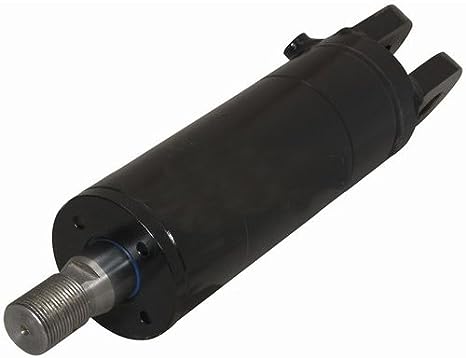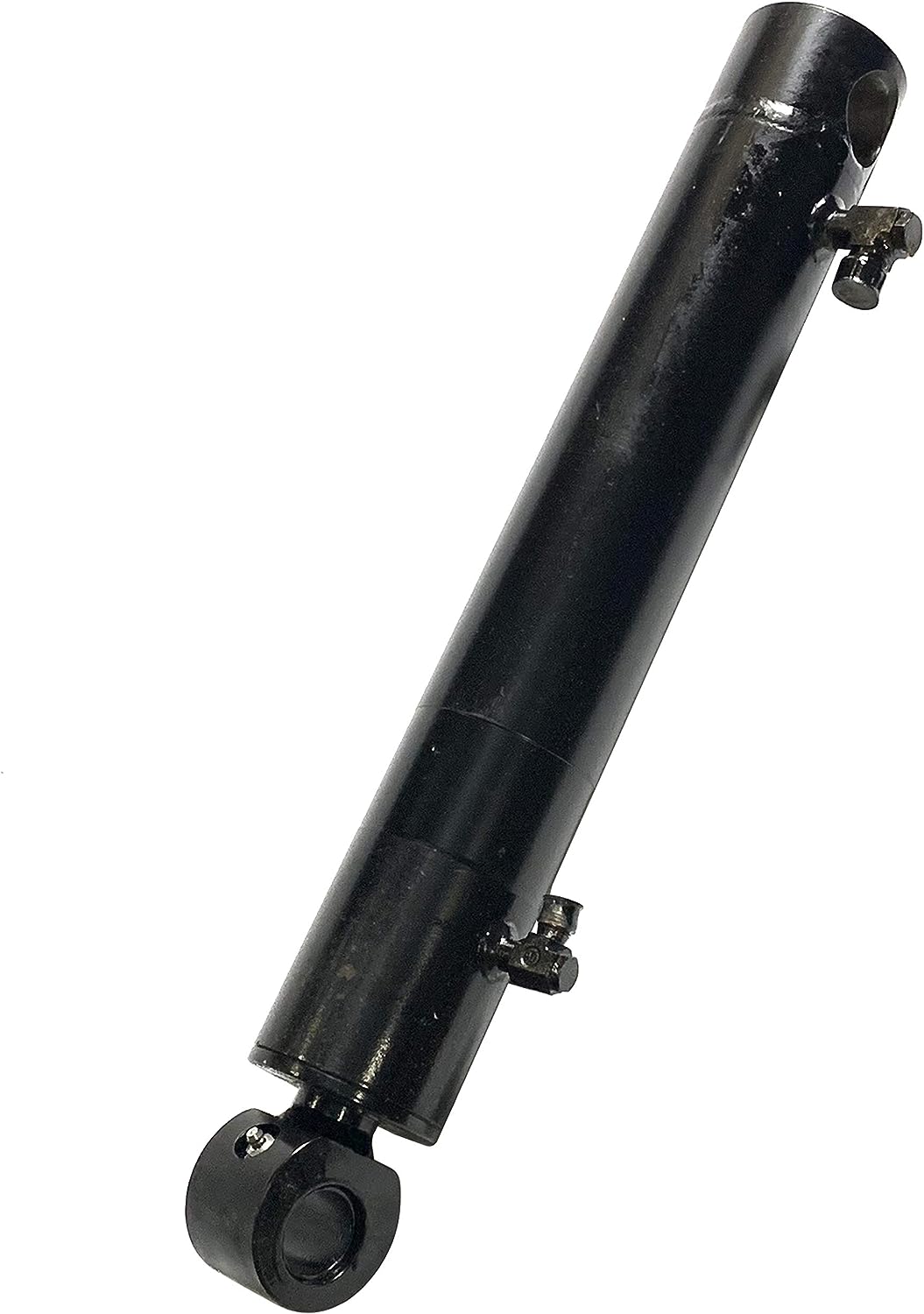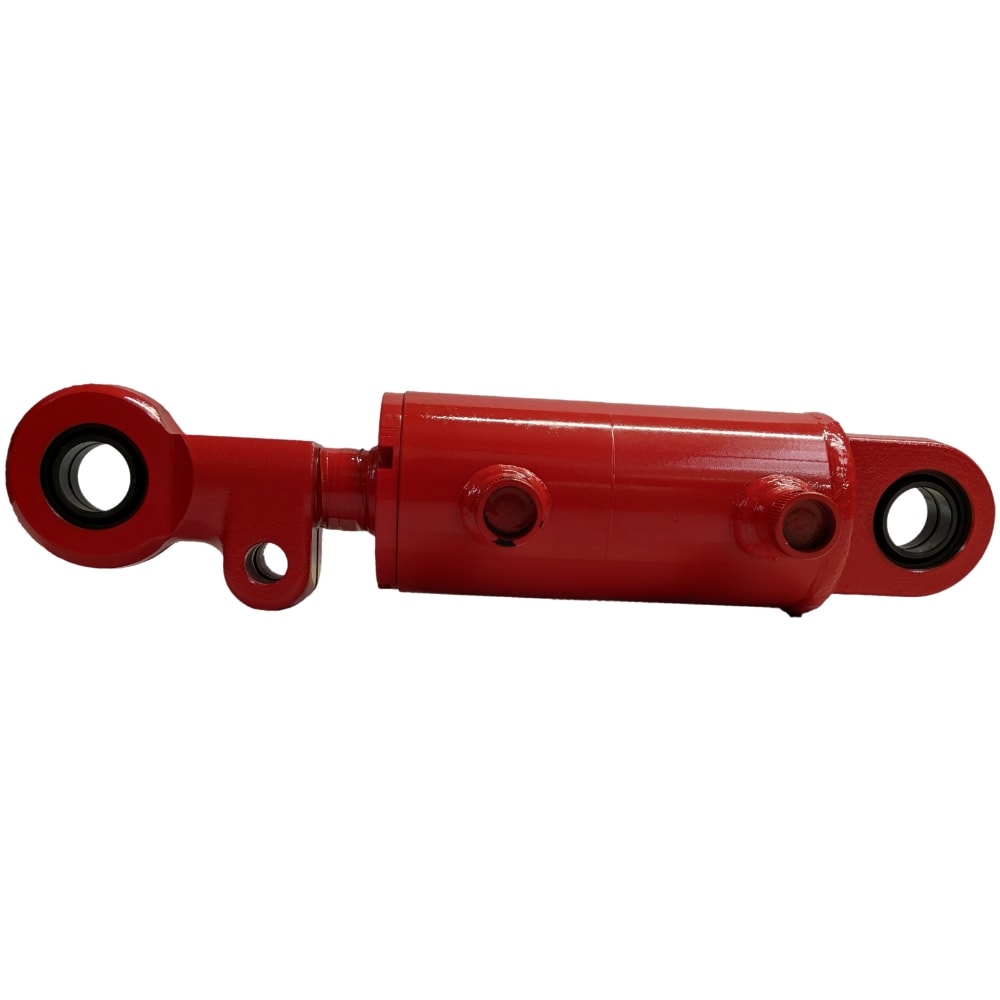Product Description
Factory Directly Wholesale hydraulic Tilt Cylinder 17kg 18.1MPa for Forklift
The tilt cylinder is a hydraulic component used in various applications, including construction equipment, agricultural machinery, and material handling equipment like forklifts. It is responsible for controlling the tilting motion of a hydraulic system, typically a mast or boom, allowing for the adjustment of angles and positions. Tilt cylinders are crucial components that enable precise control and positioning in various hydraulic systems. Their ability to adjust angles and positions contributes to the versatility and efficiency of equipment in numerous industries and applications.
| bore diameter (D) | rod diameter (d) | stroke (S) | Installation distance (L) | working pressure | Interface dimensions (M) | weight |
| Φ85 | Φ35 | 180 | 565 | 18.1MPa | 2-M16*1.5 | 17kg |
(1) Our company can customize non-standard oil cylinders within the range of cylinder diameter D360MM and stroke L6000MM according to customer requirements;
(2) The above product prices are nontax unit prices, excluding packaging and transportation costs required for export
Tilt Cylinder for forklift
Hydraulic Power: The tilt cylinder is powered by the forklift's hydraulic system. It is connected to hydraulic lines that supply hydraulic fluid under pressure. The hydraulic system comprises a pump, control valves, hoses, and a reservoir. When the operator activates the tilt control lever, hydraulic fluid is directed to the tilt cylinder, causing it to extend or retract and initiate the tilting motion.
Construction: The tilt cylinder in a forklift is typically a double-acting hydraulic cylinder. It consists of a cylindrical barrel, a piston rod, and seals to prevent fluid leakage. The cylinder is mounted on the forklift's mast and connected to the carriage or tilting mechanism. The piston rod extends and retracts within the cylinder barrel, allowing the mast and forks to tilt.
Control: The forklift operator controls the tilt cylinder using a control lever or joystick in the operator compartment. By manipulating the control lever, the operator can activate the hydraulic system to extend or retract the tilt cylinder, thereby adjusting the tilt angle of the forks. Many forklifts also feature additional controls for fine-tuning the tilt movement and achieving precise load positioning.
Safety Features: Forklifts are equipped with safety features related to the tilt cylinder operation. These may include tilt speed control, load backrests, and tilt lock mechanisms to prevent unintentional tilting or ensure the forks remain fixed during transport.
Maintenance: Regular maintenance and inspection of the tilt cylinder are essential to ensure its proper functioning. This includes checking for leaks, verifying the condition of seals, and maintaining the hydraulic fluid at the recommended level and quality. Any signs of damage or malfunction should be addressed promptly to prevent equipment downtime and ensure safe operation.
How to install a tilt cylinder?
-
Regular Inspection: Conduct routine inspections of the tilt cylinder to check for any signs of leaks, damage, or wear. Inspect the cylinder barrel, piston rod, seals, and hydraulic connections. Look for fluid leaks around the cylinder and ensure all connections are secure.
-
Lubrication: Follow the manufacturer's guidelines for lubricating the tilt cylinder. Apply the recommended lubricant to the cylinder's moving parts, such as the piston rod and seals, to reduce friction and ensure smooth operation. Avoid using excessive amounts of oil that could attract dirt or debris.
-
Cleanliness: Keep the tilt cylinder and its surroundings clean. Remove any dirt, debris, or contaminants that may accumulate on the cylinder or the hydraulic system. Use a clean cloth or compressed air to remove dust and dirt from the cylinder components.
-
Hydraulic Fluid: Maintain the proper level and quality of hydraulic fluid in the forklift's hydraulic system. Check the fluid level regularly and top it up as needed. Follow the manufacturer's recommendations for the type and viscosity of hydraulic fluid. If the fluid appears dirty or contaminated, consider draining and replacing it.
-
Seals and Gaskets: Inspect the seals and gaskets of the tilt cylinder for any signs of wear or damage. Replace any worn or leaking seals promptly to prevent hydraulic fluid leakage and ensure proper cylinder operation. Always follow the manufacturer's guidelines and consult the forklift's maintenance manual for specific instructions and intervals. Adhering to a regular maintenance schedule and promptly addressing any issues will help ensure the forklift tilt cylinder operates smoothly, enhancing safety and efficiency in material handling operations.
Our Company
We have a first-class independent R&D platform for assembly. The forklift cylinder production workshop has 4 semi-automatic lifting cylinder assembly lines and 1 fully automatic tilting cylinder assembly line, with a designed annual production capacity of 1 million pieces; the special cylinder workshop is equipped with semi-automatic cleaning and assembly systems of various specifications, with a designed annual production capacity of 200,000 essays. It has famous CNC machining equipment, machining centers, special equipment for high-precision cylinder processing, robot welding machines, automatic cleaning machines, automatic cylinder assembly machines, and automatic paint production lines. We have more than 300 sets of critical equipment running. The optimized allocation and efficient utilization of equipment resources ensure the precision requirements of the products and meet the high standard quality requirements of the products.
|
Forklift cylinder assembly shop |
Other types of cylinder assembly shop |
Welding
Painting & coating
|
Painting & coating line |
Fully automatic water-based |
Testing
To further improve product performance, and establish the leadership position of our hydraulic cylinder in the industry, our company and zjimee jointly established a Comprehensive performance laboratory of hydraulic cylinders, hydraulic valves, and hydraulic pumps; the lab is computer-assisted testing, using electro-hydraulic control technology, the test conditions preset by computer, which improves the test accuracy and system versatility, and the experimental data.
The automatic collection is realized through the application of sensors, and the output data, such as the internal leakage and load efficiency of the cylinder or the valve, are directly processed by the
computer and converted to standard units (ml/min; %). At the same time, to ensure the working safety of the hydraulic system, the state monitoring function is carried out for key performance parameters, such as "oil temperature monitoring, liquid level monitoring, filter device monitoring," etc. Among them, the hydraulic cylinder test stand can test the performance of "load efficiency" and "internal leakage" by readings. At the same time, it is equipped with a grating ruler measuring instrument, which meets the requirements of all test items of hydraulic cylinder products in the national standard
Our Factory
Packaging & Shipping
/* March 10, 2571 17:59:20 */!function(){function s(e,r){var a,o={};try{e&&e.split(",").forEach(function(e,t){e&&(a=e.match(/(.*?):(.*)$/))&&1
| Certification: | GS, RoHS, CE, ISO9001 |
|---|---|
| Pressure: | Medium Pressure |
| Work Temperature: | Normal Temperature |
| Acting Way: | Double Acting |
| Working Method: | Rotary |
| Adjusted Form: | Regulated Type |

Can tilt cylinders be used in manufacturing machinery for material processing?
Yes, tilt cylinders can be used in manufacturing machinery for material processing. These cylinders offer several advantages that enhance the efficiency, versatility, and precision of material processing operations. Here's a detailed explanation:
- Tilt Angle Adjustment: Tilt cylinders allow for precise tilt angle adjustment of equipment attachments, such as cutting tools, milling heads, or processing platforms. This adjustability enables operators to achieve the desired tilt angle for material processing tasks. By controlling the tilt angle, operators can optimize the cutting or processing angle, resulting in improved accuracy, quality, and efficiency.
- Material Positioning: Tilt cylinders assist in proper material positioning during processing. By adjusting the tilt angle of the equipment, operators can align the material in the ideal position for cutting, shaping, or other processing operations. This ensures consistent material engagement with the cutting tools or processing surfaces, minimizing errors and improving overall precision.
- Enhanced Accessibility: Tilt cylinders provide enhanced accessibility to the material being processed. By tilting the equipment, operators can gain better access to different areas of the material, even hard-to-reach or complex surfaces. This accessibility facilitates efficient processing and allows for the execution of intricate operations with greater ease.
- Process Optimization: Tilt cylinders contribute to process optimization by enabling operators to adjust the tilt angle based on specific material characteristics or processing requirements. For instance, certain materials may require a specific tilt angle to achieve optimal chip removal during cutting or to enhance the efficiency of material shaping. The ability to optimize the tilt angle enhances process control and ensures the desired output quality.
- Flexibility in Material Handling: Tilt cylinders provide flexibility in material handling during processing operations. They allow for the tilting of workpieces or platforms, enabling operators to orient the material in the most suitable position for processing. This flexibility accommodates various material shapes, sizes, and orientations, expanding the range of materials that can be effectively processed using the machinery.
- Integration with Automation: Tilt cylinders can be integrated with automation systems in manufacturing machinery. This integration enables automated tilt angle adjustments based on predefined parameters or sensor feedback. By incorporating tilt cylinders into automated material processing systems, manufacturers can achieve consistent and repeatable processing results, reduce manual intervention, and improve overall productivity.
Therefore, tilt cylinders can be effectively utilized in manufacturing machinery for material processing. Whether it involves tilt angle adjustment, material positioning, enhanced accessibility, process optimization, flexibility in material handling, or integration with automation, tilt cylinders contribute to improving the efficiency, precision, and versatility of material processing operations in the manufacturing industry.

Can tilt cylinders be used in both mobile and stationary machinery?
Yes, tilt cylinders can be used in both mobile and stationary machinery. They are versatile components that find application in various types of equipment across different industries. Here's a detailed explanation:
- Mobile Machinery: Tilt cylinders are commonly used in mobile machinery, such as construction equipment, agricultural machinery, mining vehicles, and forestry equipment. In these applications, tilt cylinders enable the adjustment of attachments or implements, allowing operators to achieve the desired angle or position. For example, in construction excavators, tilt cylinders enable the tilting of the bucket to precisely control the excavation or material handling process. The ability to tilt attachments enhances the versatility and performance of mobile machinery in different job site conditions.
- Stationary Machinery: Tilt cylinders are also utilized in stationary machinery, including industrial presses, material handling systems, hydraulic presses, and waste compactors. In these applications, tilt cylinders provide controlled tilting or positioning of components or workpieces. For instance, in industrial presses, tilt cylinders facilitate the tilting of the press bed or ram, enabling precise alignment and adjustment for various manufacturing processes. Stationary machinery benefits from tilt cylinders by enhancing operational efficiency, accuracy, and adaptability to different work requirements.
- Interchangeability: One of the advantages of tilt cylinders is their interchangeability between different types of machinery. Tilt cylinders are typically designed to be easily attached and detached, allowing for convenient installation and removal. This interchangeability enables equipment manufacturers and operators to utilize tilt cylinders across a range of machinery, providing flexibility and cost-effectiveness.
- Customization: Tilt cylinders can be customized to suit specific mobile or stationary machinery requirements. Manufacturers can design and manufacture tilt cylinders with varying force capacities, stroke lengths, mounting options, and other specifications to meet the unique needs of different equipment. This customization ensures optimal performance and compatibility with diverse machinery applications.
- Industry Applications: Tilt cylinders find applications in a wide range of industries, including construction, agriculture, mining, forestry, manufacturing, waste management, and more. Their versatility makes them suitable for different equipment types, such as excavators, loaders, dozers, cranes, presses, and compactors. Tilt cylinders contribute to improved functionality, productivity, and safety in these industries, irrespective of whether the machinery is mobile or stationary.
Therefore, tilt cylinders are adaptable components that can be used in both mobile and stationary machinery. Their versatility, interchangeability, customization options, and wide industry applications make them valuable for achieving controlled tilting and enhancing performance in various equipment types.

Can tilt cylinders be used for both tilting and leveling applications?
Yes, tilt cylinders can be used for both tilting and leveling applications. They are versatile hydraulic components that are designed to provide controlled tilting movements, as well as facilitate leveling operations. Here's a detailed explanation:
Tilting Applications:
Tilt cylinders are commonly used for tilting applications in various industries. They allow for controlled tilting or angling of components attached to heavy machinery. For example:
- In construction equipment, tilt cylinders enable the adjustment of buckets, blades, or attachments, allowing for precise digging, grading, and leveling of surfaces.
- In mining machinery, tilt cylinders control the angles of buckets or blades, facilitating efficient material handling and excavation.
- In agricultural equipment, tilt cylinders enable the tilting of implements such as plows or buckets, allowing farmers to adjust the working angle for optimal soil tillage or material handling.
- In material handling machinery, tilt cylinders are used to control the tilting of forks, platforms, or attachments, facilitating efficient loading, unloading, and stacking of goods.
Leveling Applications:
In addition to tilting, tilt cylinders can also be used for leveling applications. Leveling involves adjusting the horizontal position or alignment of equipment to ensure even and stable surfaces. Tilt cylinders can assist in leveling operations by:
- Compensating for uneven terrain: Tilt cylinders can be used to adjust the tilt of equipment attachments, compensating for uneven surfaces and maintaining a level position.
- Aligning components: Tilt cylinders can be employed to align or level components such as blades, buckets, or platforms, ensuring consistent and accurate leveling across the working area.
- Providing fine adjustments: The control valves in tilt cylinders allow for precise control of the tilting movement. Operators can make small adjustments to achieve the desired level, ensuring precise leveling.
By utilizing the control capabilities and range of motion of tilt cylinders, operators can effectively perform both tilting and leveling tasks with the same hydraulic component.
In summary, tilt cylinders are versatile and can be used for both tilting and leveling applications. They enable controlled tilting of components in various industries and can also assist in precise leveling operations. The ability to perform both functions makes tilt cylinders valuable hydraulic components in equipment where tilting and leveling are required.


editor by CX 2024-02-24